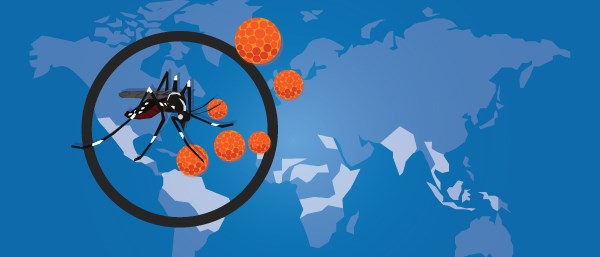Zika has gained worldwide attention as an emerging virus, especially with regard to dangerous complications affecting the unborn. In an increasingly interconnected world, the emergency physician must be able to recognize a possible infection, manage symptoms, and recommend methods of prevention.
These 10 tips will help in that endeavor.
1 The Zika virus (ZIKV) is a member of the Flaviridae family and is transmitted by arthropods – most notably the mosquitoes of the genus Aedes, but not exclusively by them. It is a virus that is widely circulated in Central and South America,1 as well as the Caribbean. Ask patients presenting with fever or a history of fever about recent travel.
2 Viral transmission occurs mainly through a bite from the female Aedes mosquito. However, transmission may also occur human-to-human. The main period of transmission is during pregnancy or around the time of birth.2 There are also cases of infection through sex (high viral loads in semen have been reported) and through blood transfusions.3
3 80% of Zika virus-infected people do not develop any symptoms, and 20% develop a mild symptomatology in an extremely narrow time window of about 5-7 days. The most common symptoms are a rather itchy skin rash, low-grade fever, arthralgia, non-purulent conjunctivitis, myalgia, headache, and retro-ocular pain.
4 Low-grade fever, the presence of conjunctivitis, and extremely itchy maculopapular erythema that may be able to differentiate a Zika virus infection from other Aedes transmitted viral infections, such as dengue and chikungunya.4-6
5 It is particularly significant to be able to detect a co-infection with dengue7 for early treatment and avoidance of NSAIDS during therapy, which may increase risk of bleeding in patients with dengue. Malaria also must be ruled out.
6 Zika is a neurotrophic virus. Complications fall under the umbrella term “neuro-Zika syndrome,” which is a number of diseases that affect the nervous system. The most diffuse among them is Guillain-Barré syndrome (GBS).8-10 In pregnant women, Zika infection could lead to Congenital Zika Syndrome, a combination of microcephaly, intracranial calcifications, neuropsychomotor developmental delay, global hypertonia, and spastic hemiplegia. 11
7 Diagnosis is based on clinical, epidemiological, and laboratorial criteria. Zika can be isolated from biological fluids, including blood, urine, semen, CSF, amniotic fluids, breast milk, and cord blood. The virus is eliminated from blood rather quickly (2-3 days), but in the urine this virus continues to be excreted weeks from the onset of the infection. RT-PCR tests show high sensitivity and specificity (roughly 100%).12-13 ELISA can detect Zika-specific IgM and IgG from day 5 or 6 after the onset of symptoms. However, regarding the serologic tests, it is necessary to recognize the chance of false positivity because of cross-reaction with other flaviviruses in patients previously infected by them.
8 Zika is a self-limiting disease. Currently there is neither a vaccine nor a specific antiviral therapy for treatment. The treatment is supportive (bed rest, appropriate fluid intake, antipyretic medications). Acetaminophen is the recommended antipyretic, and antihistamines can be used for pruritus.14
9 In the absence of a vaccine, the goal of prevention is to reduce the number of vector insects and the bite rate. Wearing long-sleeved clothing, uniformly applying topical repellents on uncovered body parts, sealing or shielding any openings in the house, installing bed nets (and using them even during the daytime), avoiding stagnant water, and using fans and air conditioning eliminates potential breeding sites of Aedes mosquitoes.15
10 Pregnant women or those wishing to become pregnant should avoid or delay travel to areas where Zika is present. Additionally, they should consider condom usage. During prenatal care in endemic areas, serial ultrasounds are suggested every 3-4 weeks to search the central nervous system for abnormalities.16
References
- Gatherer D, Kohl A. Zika virus: a previously slow pandemic spreads rapidly through the Americas. ”ŽJ. Gen. Virol. 2016;97:269–73.
- Besnard M, Lastère S, Teissier A, et al. Evidence of perinatal transmission of Zika virus French Polynesia, December 2013 and February 2014. Euro Surveill. 2014;19:20751.
- Foy BD, Kobylinski KC, Foy JLC, et al. Probable nonvector-borne transmission of Zika virus Colorado, USA. Emerg Infect Diseases. 2011;17:880–882.
- Rios-González CM, Díaz-Vélez C. Knowledge about dengue Zika and chikungunya in Latin American students, 2016. Medicina Universitaria. 2016;18:134–135.
- Laoprasopwattana K, Kaewjungwad L, Jarumanokul R, et al. Differential diagnosis of chikungunya dengue viral infection and other acute febrile illnesses in children. Pediatr Infect Dis J. 2012;31:459–463.
- Beltrán-Silva SL, Chacón-Hernández SS, Moreno-Palacios E, et al. Clinical and differential diagnosis: Dengue chikungunya and Zika. Revista Médica del Hospital General de México Published Online First: October 2016. doi:10.1016/j.hgmx.2016.09.011
- Long D, Long B, Koyfman A. Zika virus: What do emergency physicians need to know? J. Emerg. Med. 2016;50:832–838.
- Oehler E, Watrin L, Larre P, et al. Zika virus infection complicated by Guillain-Barré syndrome case report French Polynesia, December 2013. Euro Surveill. 2014;19:20720.
- Watrin L, Ghawché F, Larre P, et al. GuillainBarré syndrome (42 cases) occurring during a Zika virus outbreak in French Polynesia. Medicine. 2016;95:e3257.
- Wise J. Study links Zika virus to Guillain-Barré syndrome. The BMJ. 2016;i1242.
- Rasmussen SA, Jamieson DJ, Honein MA, et al. Zika virus and birth defects reviewing the evidence for causality. N Engl J Med. 2016;374:1981–1987.
- Burkhalter KL, Savage HM. Detection of Zika virus in desiccated mosquitoes by real-time reverse transcription PCR and plaque assay. Emerg Infect Diseases. 2017;23.
- Faye O, Diallo D, et al. Quantitative real-time PCR detection of Zika virus and evaluation with field-caught mosquitoes. Virol. J. 2013;10:311.
- Moghadam SRJ, Bayrami S, Moghadam SJ, et al. Zika virus: A review of literature. Asian Pac J Trop Biomed. 2016;6:989–994.
- Troyo A, Calderón-Arguedas O, Fuller DO, et al. Seasonal profiles of Aedes aegypti (diptera: culicidae) larval habitats in an urban area of Costa Rica with a history of mosquito control. J Vector Ecol. 2008;33:76–88.
- Chen Y-N, Chen C-P, Lin C-J, et al. Prenatal ultrasound findings of pregnancy associated with Zika virus infection. J Med Ultrasound. 2016;24:89–92.



